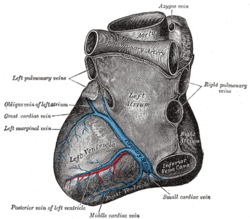Smallest cardiac veins
The smallest cardiac veins (or Thebesian veins)[1][2] are minute valveless veins in the walls of all four heart chambers.[3] The veins are sometimes accurately referred to as vessels, but they are frequently confused[4] with a distinct set of artery connections[5][6][7] eponymously referred to as the "vessels of Wearn".[8] In his 1928 publication, Wearn himself referred to the arterio-cameral connections (vessels of Wearn) as thebesian.[9] However, Wearn's 1933 and 1941 publications emphatically described the thebesian veins as distinct from arterio-cameral vessels.
| Smallest cardiac veins | |
|---|---|
 | |
| Details | |
| Identifiers | |
| Latin | Venae cardiacae minimae, venae cordis minimae |
| TA | A12.3.01.013 |
| FMA | 71568 |
| Anatomical terminology | |
The thebesian veins are most abundant in the right atrium and least in the left ventricle.[10] They drain the myocardium[11] and run a perpendicular course to the endocardial surface, directly connecting the heart chambers to the medium-sized, and larger coronary veins.[12] Thebesian veins have been successfully identified by following the route of contrast flow - during catheterization procedures - from the subendocardium, through the thebesian veins, into larger veins, and into the coronary sinus.[13][14] The coronary sinus empties into the right atrium.
The thebesian venous network is considered an alternative venous drainage of the myocardium. Thebesian veins draining into the left heart, along with deoxygenated blood originating from the bronchial veins draining into the pulmonary veins, contribute to normal physiologic shunting of blood. As a consequence of the input of these vessels, blood in the left heart is less oxygenated than the blood found at the pulmonary capillary beds, albeit to a very small degree.
The openings of smallest cardiac veins are located in the endocardium. Here the smallest cardiac veins return blood into the heart chambers from the capillary bed in the muscular cardiac wall, enabling a form of collateral circulation unique to the heart. Not every endocardial opening connects to the thebesian veins as some connect to the vessels of Wearn, which are arteries. Therefore, the endocardial opening must be traced to a vein before it is definitely called an opening of the smallest cardiac veins.
The thebesian veins are named after the German anatomist Adam Christian Thebesius, who described them in a 1708 treatise called Disputatio medica inauguralis de circulo sanguinis in corde.[15][16]
References
- Singhal, S; Khoury, S (2008). "Images in clinical medicine. Imaging of thebesian venous system". The New England Journal of Medicine. 359 (7): e8. doi:10.1056/nejmicm072885. PMID 18703466.
- Smith, TM (2009). "Rare view of thebesian venous system". Radiologic Technology. 81 (2): 173–4. PMID 19901354.
- Blake, HA; Manion, WC; Mattingly, TW; Baroldi, G (1964). "Coronary artery anomalies". Circulation. 30: 927–40. doi:10.1161/01.cir.30.6.927. PMID 14246341.
- Boeder, NF; Nef, HM; Bauer, T (2016). "Thebesian veins as drainage to the ventricle: A case report". Cardiovascular Revascularization Medicine. doi:10.1016/j.carrev.2016.09.007. PMID 27743821.
- Grollman, JH Jr (1998). "Re: three major coronary artery-to-left ventricular shunts". Cardiovascular and Interventional Radiology. 21 (2): 183. doi:10.1007/s002709900240. PMID 9502691.
- Wearn, JT (1941). "Morphological and functional alterations of the coronary circulation". Bulletin of the New York Academy of Medicine. 17 (10): 754–777. PMC 1933738. PMID 19312228.
- Wearn, JT; Mettier, SR; Klumpp, TG; Zschiesche, LJ (1933). "The nature of the vascular communications between the coronary arteries and the chambers of the heart". American Heart Journal. 9 (2): 143–164. doi:10.1016/S0002-8703(33)90711-5.
- Hussain, M; Roberts, EB (2015). "Association of coronary to left ventricular microfistulae (vessels of Wearn) with atrial septal defect in an adult without cyanotic heart disease". BMJ Case Reports. 2015: bcr2014207655. doi:10.1136/bcr-2014-207655. PMC 4493239. PMID 26139649.
- Wearn, JT (1928). "The rôle of the thebesian vessels in the circulation of the heart". Journal of Experimental Medicine. 47 (2): 293–315. doi:10.1084/jem.47.2.293. PMC 2131354. PMID 19869414.
- "Venae cordis minimae". radiopaedia.org. Retrieved 31 August 2019.
- Agur, AMR; Dalley, AF (2009). Grant's atlas of anatomy. Lippincott Williams & Wilkins. pp. 53–. ISBN 978-0-7817-7055-2. Retrieved 31 October 2010.
- Pratt, FH (1898). "The nutrition of the heart through the vessels of Thebesius and the cardiac veins" (PDF). American Journal of Physiology. 1: 86–103.
- Judkins, C; Yamen, E (2013). "Inadvertent thebesian vein cannulation during radial access ventriculography". JACC: Cardiovascular Interventions. 6 (2): e9–e10. doi:10.1016/j.jcin.2012.09.014. PMID 23428022.
- Gach, O; Lempereur, M; Eeckhout, E; Legrand, V (2014). "Unintentional "ventriculo-phlebo-myo-pericardiography"". JACC: Cardiovascular Interventions. 7 (5): 577–578. doi:10.1016/j.jcin.2013.07.024.
- synd/4013 at Who Named It?
- Thebesius, AC (1708). Disputatio medica inauguralis de circulo sanguinis in corde. Doctoral dissertation, Leiden.